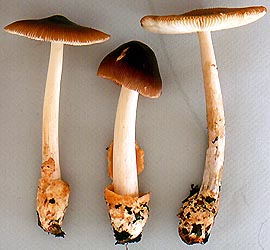|
[ Section Vaginatae page. ]
[ Amanita Studies home. ]
[ Keys & Checklist/Picturebooks ] "Mesoamerican Orange-Brown Ringless Amanita"
Technical description (t.b.d.) BRIEF DESCRIPTION: The cap of Amanita fuligineodisca is usually free of volval remnants, 20 - 70 (-120) mm wide, umbonate at maturity, with a strongly striate margin; it is dark orange-brown, paler at the margin, and darker (even very dark brown) in the center; infrequently, the entire cap may be paler than just described. Gills are free to very narrowly adnate, close to subdistant, white to whitish to buff in mass, and 4 - 8 mm broad, not or rarely marginate and then having edge concolorous with cap; gills are truncate, of varying length, adjacent to margin or stem or neither. The stem is 70 - 150 (-180) x 3 - 14 (-25) mm, predominantly white, and exannulate, with a membranous sack-like volva at the base. Both the internal and external surfaces of the up to 40 mm high volval sack commonly take on orange-brown or rusty stains. The spores measure (7.5-) 9.0 - 12.0 (-15.5) x (6.5-) 8.4 - 11.2 (-15.0) µm and are globose to subglobose (occasionally broadly ellipsoid) and inamyloid. Clamps are not present at bases of basidia. Amanita fuligineodisca is known from Honduras to Andean Colombia, occurring with oak. Prior to description of A. fuligineodisca, collections of this species were commonly assigned to A. fulva (Schaeff.) Fr., which is quite similar macroscopically. Other, similar, Western Hemisphere species remain to be formally described. A short key-fragment is available. It is useful in distinguishing A. crocea (Quél. in Bourd.) Singer ex Singer, A. flavescens (E.-J. Gilbert & S. Lund.) Contu, A. romagnesiana Tulloss, and A. subnudipes (Romagn.) Tullossas well as the species most phenetically similar to A. fulva (Schaeff.) Fr. -- R. E. Tulloss Photo: R. E. Tulloss (Costa Rica)
[ Section Vaginatae page. ]
[ Amanita Studies home. ]
[ Keys & Checklist/Picturebooks ] Last changed 5 October 2009. |
